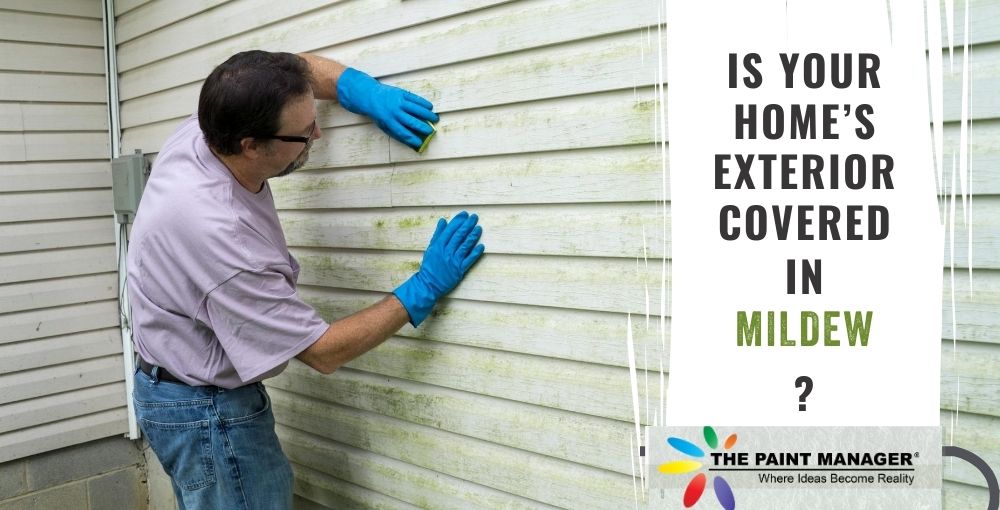Every Florida homeowner dreads the sight of black spots spreading across their home’s exterior. Mildew has taken up residence and needs to be evicted a.s.a.p. In addition to ruining the curb appeal of your residence, mildew causes significant damage if not removed. If you’re a newcomer to the Sunshine State, you may be wondering what mildew is, how it got there, and what to do about it – as well as steps you can take to prevent regrowth.
What is mildew?
According to the Environmental Protection Agency (EPA), mildew refers to certain kinds of mold or fungus. The term mildew is often used generically to refer to mold growth, usually with a flat growth habit. Molds include all species of microscopic fungi that grow in the form of multicellular filaments, called hyphae.
While that last part may be too technical, just know that you don’t want mildew around. Causes can include failure to prime a bare wood surface before painting, painting over a surface previously infected with mildew, and excess humidity or other moisture problems. Considering that Florida is known for its humidity, keeping mildew at bay is a constant battle.
Is mildew just cosmetic damage?
Left unchecked, mildew can damage paint, as well as the building material itself. At this stage of neglect, pressure washing the exterior is likely to remove the paint in the process of removing the mildew. Worse yet is when the mildew has worked its way to the siding, shingles, etc., necessitating its replacement. Even when mildew occurs outdoors, it poses a health hazard. Andy Nitkowski – owner of Pro Wash Services, Milford, Del. – elaborates.
“Mold and mildew are the biggest health risks to those with allergies but they can be dangerous to anyone. Not only is it dangerous for people, but it can also cause serious structural damage to your home. It not only affects your siding but can appear on shingles, wood decking, and even concrete.”
In addition to exterior walls, mildew can grow in gutters – which are especially susceptible if they aren’t cleaned on a regular basis. More on that later.
How to get rid of mildew and keep it from returning?
As you may have gathered by now, painting over mildew only conceals the problem – and not for very long. In fact, it will make removal even more difficult. Some homeowners are left dealing with this situation soon after buying a house the previous owner painted for just this reason. However, a professional house painter will inform the homeowner about the problem after evaluating the home to submit a bid and refuse to do the job unless the house is first pressure washed and determined to be mildew-free.
Zapping mildew when it first appears is crucial to preventing it from taking hold. The pros at New Life Painting, Santa Ynez, CA, provide detailed removal methods for a variety of building materials – including wood, vinyl siding, brick, and stone. These methods use typical household cleaners, such as chlorine bleach and laundry detergent – as well as manual scrubbing. However, you may prefer an all-purpose mold and mildew cleaning solution that can be purchased at home improvement centers and hardware stores, and a water hose tool specific for cleaning exteriors. Follow label instructions for cleaners and manufacturer’s instructions for cleaning equipment.
Of course, pressure washing it yourself is an option, if you own a pressure washer or are handy enough to rent one for the job. Our blog post – “Pressure Washing: Should You Hire a Pro or DIY?” – covers the pros and cons of each. If you decide to rent, talk to the rental associate at the home improvement center, describe your house, and get a recommendation on the type of pressure washer and accessories you’ll need. Being upfront about your experience level will result in detailed, helpful advice and instructions that will allow you to do the best job in the safest way. Should you decide to leave it to a pro, call us at The Paint Manager!
Don’t stop with the exterior – clean the deck and porch
Decks and porches are also susceptible to mildew growth. Decks and railings usually remain damp during the rainy season, which makes them prone to mildew. If you have a covered deck or it’s located in a shady area, it is more vulnerable because water can’t evaporate easily. That is why you need to remove mildew as soon as you see it appear.
Of course, prevention is preferable to treatment. To prevent mildew growth, keep plants trimmed back from painted surfaces, and make sure your gutters are free of debris – which is good basic home maintenance, anyway!
Gutters are important because leaves and small twigs collect in them. As this debris decomposes, it can clog your downspouts, causing water to run over the sides of the gutters. The water that drips down your home’s siding spreads mildew to other parts of your exterior. Clean the gutters at least twice a year. An active hurricane/summer thunderstorm season may necessitate more frequent cleanings. If this is a DIY project, make sure you have the right type of equipment and protective gear. If you have any doubt about your ability to safely perform this yourself, hire a professional.
Also, when it’s time to repaint your house, choose a mildew-resistant paint. Google can help you find brands, but if you need advice about which is best for your home’s exterior, the staff at your local paint store, hardware store or home improvement center can provide more specific guidance.
If you’ve already decided to call a pressure washing professional, The Paint Manager is ready! Our team has years of experience in power washing homes of all sizes, construction materials, and ages – as well as concrete surfaces, wood decks, and fences. We use professional-grade equipment and follow OSHA guidelines. We also perform gutter clean-outs, as well as replace them! Contact us for a free estimate!

